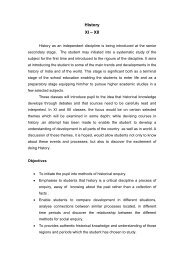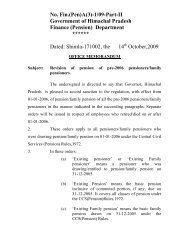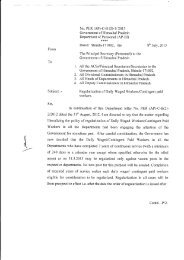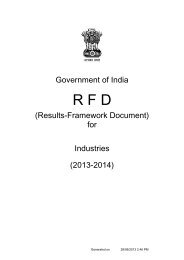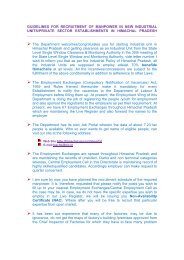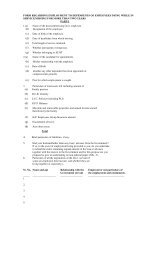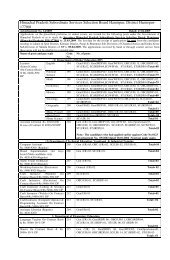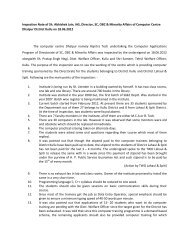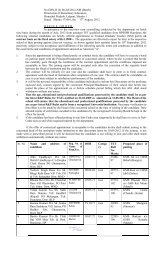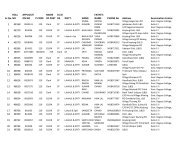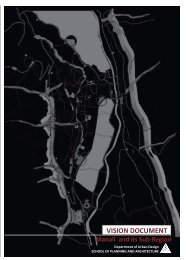Rates of chemical reactions and their dependence on the concentration of the reactants.Differential and integral rate equations for first and second order reactions. Half - lifeperiods. Temperature dependence of rate constant and Arrhenius parameters. Elementaryideas regarding collision and transition - state theory. Elementary idea of fast reactions andintroduction and principle of the techniques (stop - flow, temperature jump and field jumponly) employed to study the fast reactions.9. Photochemistry:Laws of photochemistry, quantum yield, excited singlet and triplet states. Photophysicalpathways of decay of excited states, Javlonsky diagram. Fluorescence, phosphorescenceand delayed fluorescence. photochemical reactions between hydrogen and halogens and ofcobalt(III) and chromium (III) complexes.10. Colloids, surface phenomenon and catalysis:The colloidal state, preparation and purification of colloids and their characteristicproperties. Coagulation, and protection of colloids. Gels, emulsion, microemulsion,surfactants and elementary idea of micellization of surfactants. Adsorption from gases andsolutions on solids. Adsorption - isotherms, BET isotherms. Determination of surface area.Characteristics of homogeneous and heterogeneous catalysis. Central dogma of enzymecatalyzed reactions.11. Bio-Inorganic chemistry:Essential and trace elements in biological processes, metal ions in biological systems andtheir role in ion-transport across the membranes (molecular mechanism), photosynthesis-PSI, PSH, metalloporphyrines with special reference to haemoglobin and myoglobin,nitrogen fixation, cyanide poisoning.12. Coordination chemistry:a. Introduction to theories of bonding in transition metal complexes. Valence bondstheory, crystal field theory and its modifications; application of theories in theexplanation of magnetism and electronic spectra of metal complexes.b. Isomerism in coordination compounds. IUPAC nomenclature of coordinationcompounds; stereochemistry of complexes with 4 and 6 coordination numbers;chalet effect and polynuclear complexes; trans effect and its theories; kinetics ofsubstitution reactions in square-planar complexes; thermodynamic and kineticstability of complexes.c. Synthesis and structures of metal carbonyls; carboxylate anion, carbonyl hydridesand metal nitrosyl compounds.d. Complexes with aromatic systems: Synthesis structures and bonding in metal olefin,alkyne, allyl and cyclopentadienyl complexes. Homogeneous transition metalcatalysis: Reasons for selecting transition metals in catalysis, coordinativeunsaturation, oxidative addition and reductive elimination reactions, Proximityinsertion reactions, Hydrogenation and hydroformylation reactions of alkenes,fluxional molecules and their characterization.13. General chemistry of ‘f’ block elements:Lanthanides and actinides; separation, oxidation states, magnetic and spectral properties;lanthanide contraction.14. Non-Aqueous Solvents
Reactions in liquid NH 3 , HF, SO 2 and H 2 SO 4 Failure of solvent system concept,coordination model of non-aqueous solvents. Some highly acidic media, fluoro sulphuricacid and super acids.PAPER-II1. Delocalized covalent bonding:Conjugation, Cross conjugation, Hyperconjugation, Bonding in fullerenes, Tautomerism,Aromaticity in benzenoid and non-bezenoid compounds, Anti-aromaticity,Homoaromaticity, PMO approach; Bonds weaker than covalent, Crown ethers complexes,Cryptands, Inclusion compounds, Cyclodextrins, Catanenes and Rotaxenes.2. Reaction mechanisms:(a) Kinetic and thermodynamic requirements and control of organic reactions, potentialenergy diagrams, Hammet equation and linear free energy relationship, Taftequation, Methods (both kinetic and non-kinetic) of study of mechanism of organicreactions illustrated by examples–use of isotopes, cross-over experiment,intermediate trapping and stereochemistry.(b) Reactive intermediates: Generation, geometry, stability and reactions of carboniumions, carbanions, free radicals, carbenes, benzynes and nitrenes.(c) Catalysis in Organic Chemistry: Mechanisms and applications of enzymaticcatalysis, micellar catalysis and phase transfer catalysis.(d) Substitution reactions: SN 1 , SN 2 , SNi, and SET mechanisms, Neighbouring groupparticipation and anchimeric resistance, Classical and non-classical carbonium ions,Nucleophilic reactions at an allylic and vinyl carbon, Structure and reactivityrelationship in substitution reactions, Ambident nucleophile, and Regioselectivity.(e) Elimination reactions: E 1 , E 2 , E 2 C and E 1 CB mechanisms, Spectrum of mechanisms,Effect of substrate structure on reactivity, Orientation in E 2 reactions–Saytzeff andHoffmann; Mechanism and examples of syn elimination, Mechanism of pyrolyticelimination in vapour phase, Structure and reactivity relationship in eliminationreactions.(f) Addition reactions: Electrophilic and nucleophilic addition to C=C and CC,nucleophilic addition to C=O, C=N, Conjugated olefins and carbonyls, Structure andreactivity relationship, Hydrogenation of double and triple bonds, Asymmetricsynthesis, Sharpless epoxidation.(g) Rearrangements: Pinacol-pinacolone, Demjanov ring expansion, Hoffmann,Schmidt, Lossen, Beckmann, Baeyer–Villiger, Favorskii, Fries, Claisen, Cope,Stevens, Wolf and Wagner-Meerwein rearrangements.3. Pericyclic reactions:Classification, Conservation of orbital symmetry, Woodward-Hoffmann rules—electrocyclic and cycloaddition reactions [2+2 and 4+2] and sigmatropic shifts [1, 3; 3, 3and 1, 5], FMO and PMO approach.4. Chemistry and mechanism of following reactions:Aldol condensation (including directed aldol condensation), Claisen condensation,Dieckmann, Knoevenagel, Perkin, Witting, Clemmensen, Wolff-Kishner, Cannizzaro andVon Richter reactions; Stobbe, Benzoin and acyloin condensations; Fischer indole andSkraup synthesis, Bischler-Napieralski, Sandmeyer, Reimer-Tiemann and Reformatskyreactions.5. Polymers:(a) Fundamentals of polymer science: macromolecular concept
- Page 1 and 2: (-IV ): (-4 )-(3 )-1 /2012 -171002
- Page 3 and 4: the interview is to assess the pers
- Page 5 and 6: protection equipment, their care an
- Page 7 and 8: 5.2 By products: Slaughter house by
- Page 9 and 10: (a) Paleolithic(b) Mesolithic(c) Ne
- Page 11 and 12: 10.1 Relevance in understanding of
- Page 13 and 14: III)anatomy of root, stem and leaf.
- Page 15: CO 2 . Comparison of valence bond a
- Page 19 and 20: indeterminate arches, spandrel brac
- Page 21 and 22: Meaning and Scope of Accounting: Ne
- Page 23 and 24: Business Environment: Macro and Mic
- Page 25 and 26: Functioning of money market in Indi
- Page 27 and 28: IC Technology:Overview of IC Techno
- Page 29 and 30: - The Road not taken- After Apple P
- Page 31 and 32: erosion, interruption in the cycle
- Page 33 and 34: polymorphism. Trace elements. Magma
- Page 35 and 36: Extension education and its importa
- Page 37 and 38: 10. Towards Contemporary World: Som
- Page 39 and 40: Marketing Management - Marketing an
- Page 41 and 42: Forces in three dimensions, Poinsot
- Page 43 and 44: Theory of Machines: Displacement, v
- Page 45 and 46: (a) Position, parts, relations, blo
- Page 47 and 48: (a) Carbohydrate, lipid and amino a
- Page 49 and 50: RESPIRATORY SYSTEM1. Lung volumes a
- Page 51 and 52: High Court, Session Court, Magistra
- Page 53 and 54: 3. MEDICAL JURISPRUNDENCE1. Medical
- Page 55 and 56: - Transport media- Description of c
- Page 57 and 58: ) Bacterial diseases : Pyogenic, Ty
- Page 59 and 60: c) Cirrhosis: Etiology, Postnecroti
- Page 61 and 62: (G) Hormonesa) Reproductive hormone
- Page 63 and 64: - Proportions- Risk- Sources of epi
- Page 65 and 66: - Legal status in relation to Workm
- Page 67 and 68:
- DrugsBipolar disordersDepressive
- Page 69 and 70:
_ Aspergillosis_ Histoplasmosis_ Cr
- Page 71 and 72:
_ Clinical examination of the abdom
- Page 73 and 74:
_ Venous thrombosis_ Abnormal coagu
- Page 75 and 76:
14. Biochemical and endocrine chang
- Page 77 and 78:
Disorder-Causes and types of convul
- Page 79 and 80:
12. Peritoneum and intraperitoneal
- Page 81 and 82:
• Nutritional disorders• Incomi
- Page 83 and 84:
types equation of motion under cent
- Page 85 and 86:
3. Indian System of Government:(a)
- Page 87 and 88:
Techniques of assessment (Psychomet
- Page 89 and 90:
Effect of noise, pollution and atmo
- Page 91 and 92:
12. Major issues in Indian Administ
- Page 93 and 94:
2. Uttararamacaritam (Act 1st Verse
- Page 95 and 96:
PAPER-II(i) Hypothesis; Meaning, Fu
- Page 97 and 98:
insects, metamorphosis,mouth parts,



